Garage Door Monitor and Opener
Dependencies: X_NUCLEO_COMMON ST_INTERFACES
Introduction
This system implements a simple garage door opener and environmental monitor. The hardware connects to the internet using Wi-Fi then on to the Pelion Device Management Platform which provides device monitoring and secure firmware updates over the air (FOTA). Pelion Device Management provides a flexible set of REST APIs which we will use to communicate to a web application running on an EC-2 instance in AWS. The web application will serve a web page where we can monitor and control our garage..
This project is intended to work on the DISCO-L475VG-IOT01A from ST Microelectronics It implements a simple actuator to drive a relay to simulate pushing the "open" button on older style garage doors which do not use a rolling code interface.
The system is designed to be mounted over the door so that the on board time of flight sensor can be used to detect if the door is open or closed.
The system also monitors temperature, humidity and barometric pressure.
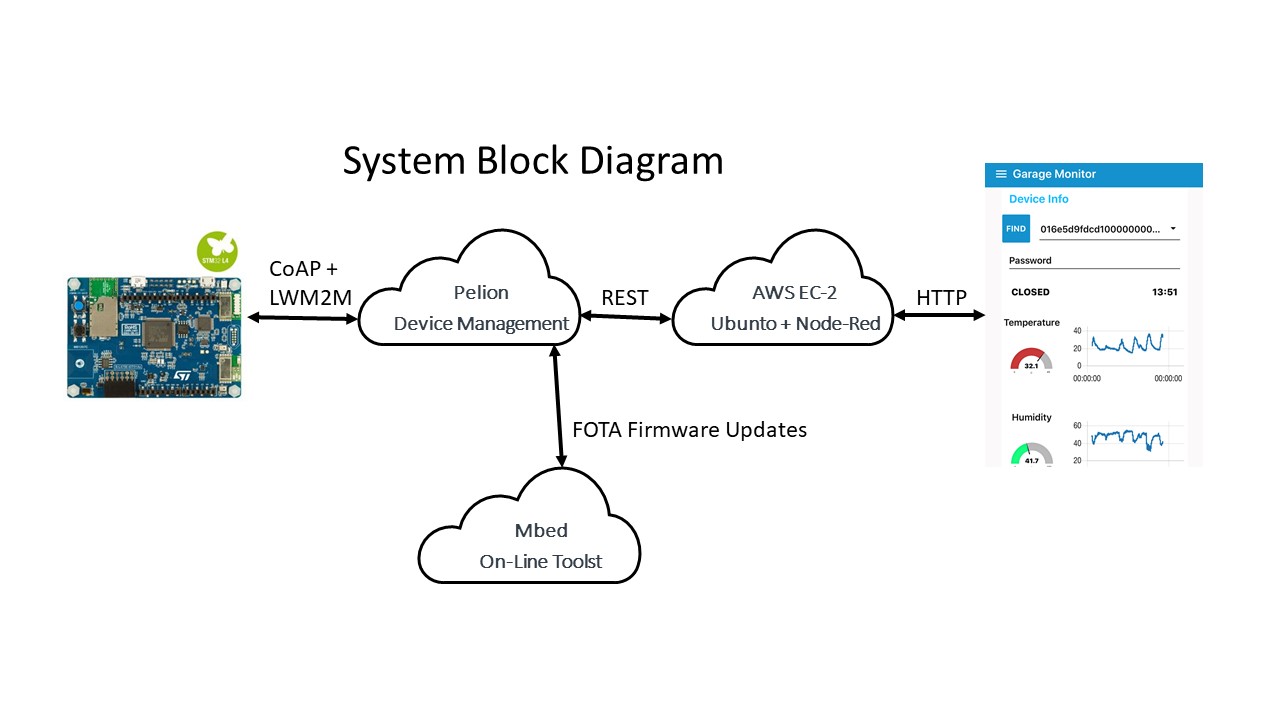
Hardware Requirements:
DISCO-L475G-IOT01A https://os.mbed.com/platforms/ST-Discovery-L475E-IOT01A/
Seeed Studio Grove Relay module https://www.seeedstudio.com/Grove-Relay.html
Seeed Studio Grove cable, I used this one: https://www.seeedstudio.com/Grove-4-pin-Male-Jumper-to-Grove-4-pin-Conversion-Cable-5-PCs-per-Pack.html
Connect to the PMOD connector like this:

This shows how I installed so that the time of flight sensor can detect when the door is open
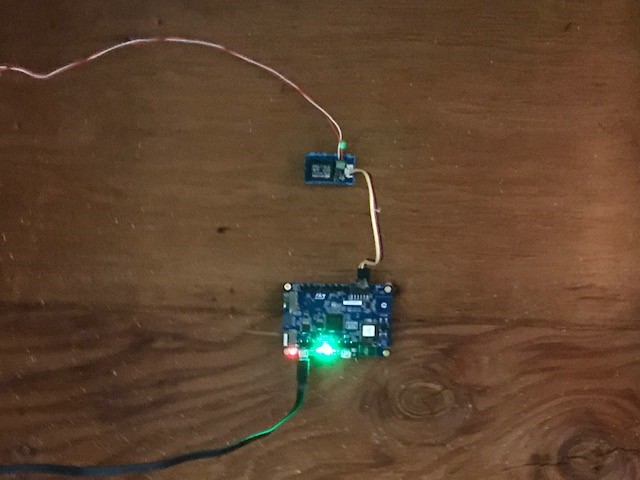
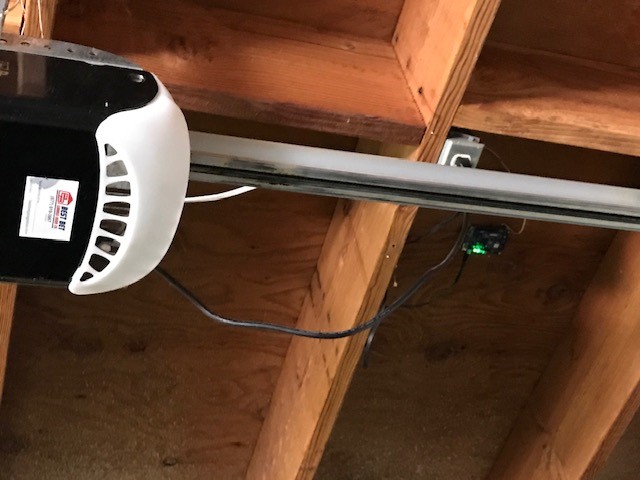
To use the project:
You will also need a Pelion developers account.
I suggest you first use the Pelion quick state to become familiar with Pelion Device Management. https://os.mbed.com/guides/connect-device-to-pelion/1/?board=ST-Discovery-L475E-IOT01A
Web Interface
For my web interface I am running node-red under Ubuntu in an EC2 instance on AWS. This can run for 12 month within the constraints of their free tier. Here is a tutorial: https://nodered.org/docs/getting-started/aws
You will also need to install several node-red add ons:
sudo npm install -g node-red-dashboard
sudo npm install -g node-red-contrib-mbed-cloud
sudo npm istall -g node-red-contrib-moment
After starting node-red import the contents of GarageFlow.txt from the project, pin the flow into the page.
To enable your web app to access your Pelion account you need an API key.
First you will neet to use your Pelion account to create an API key.
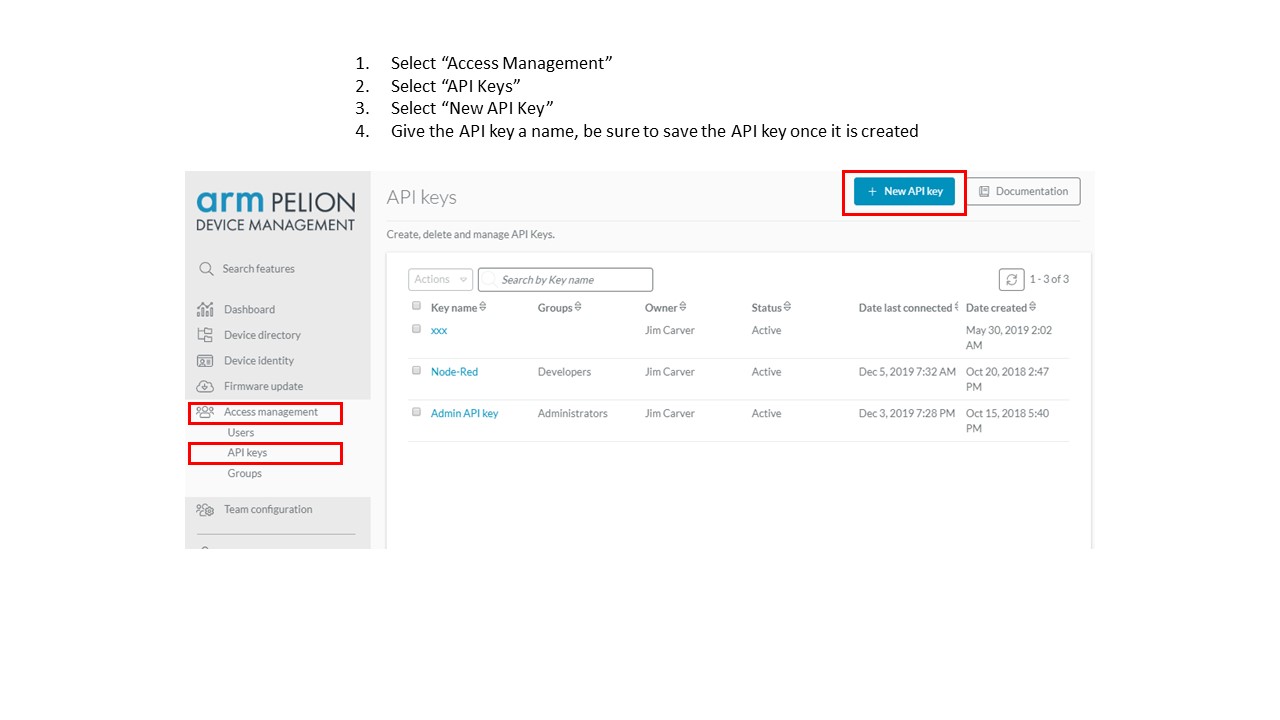
Now we need to apply that API key to your Node-Red flow.
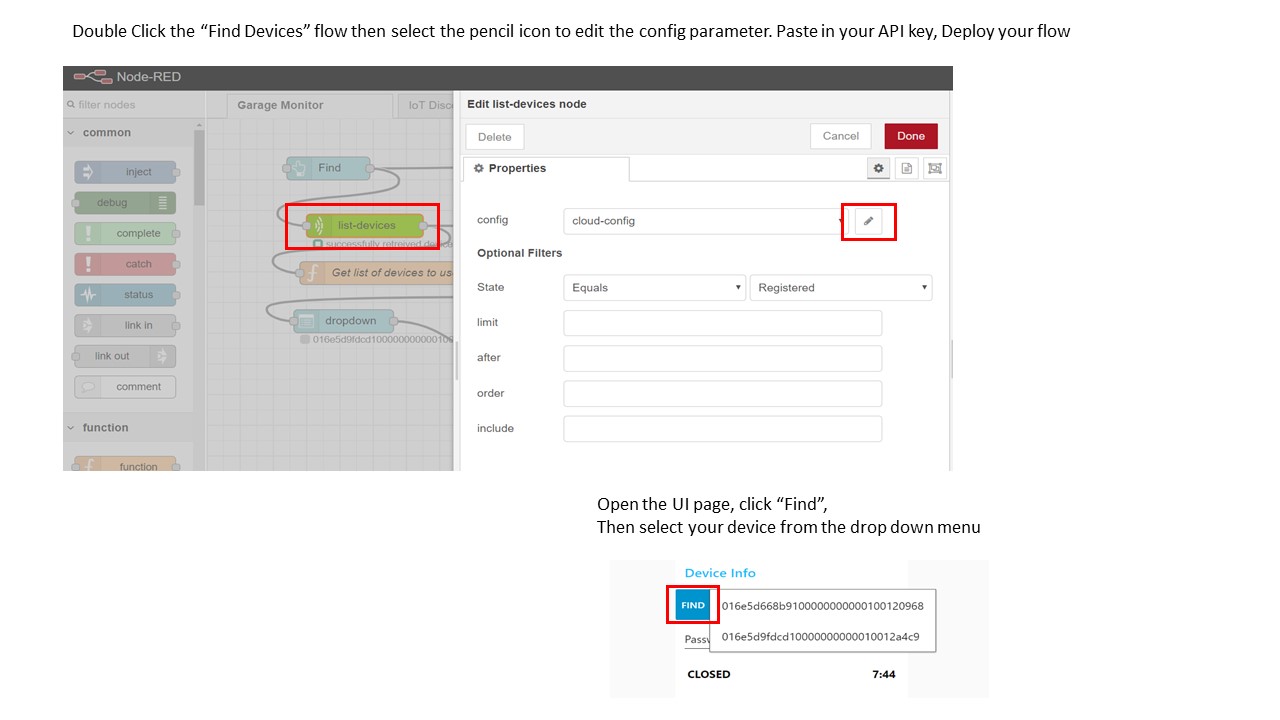
main.cpp
- Committer:
- JimCarver
- Date:
- 2019-11-27
- Revision:
- 35:cbbafa9c3e15
- Parent:
- 34:a5724eeaaf9d
- Child:
- 37:ec1124e5ec1f
File content as of revision 35:cbbafa9c3e15:
// ----------------------------------------------------------------------------
// Copyright 2016-2018 ARM Ltd.
//
// SPDX-License-Identifier: Apache-2.0
//
// Licensed under the Apache License, Version 2.0 (the "License");
// you may not use this file except in compliance with the License.
// You may obtain a copy of the License at
//
// http://www.apache.org/licenses/LICENSE-2.0
//
// Unless required by applicable law or agreed to in writing, software
// distributed under the License is distributed on an "AS IS" BASIS,
// WITHOUT WARRANTIES OR CONDITIONS OF ANY KIND, either express or implied.
// See the License for the specific language governing permissions and
// limitations under the License.
// ----------------------------------------------------------------------------
#ifndef MBED_TEST_MODE
#include "mbed.h"
#include "simple-mbed-cloud-client.h"
#include "LittleFileSystem.h"
// Default network interface object. Don't forget to change the WiFi SSID/password in mbed_app.json if you're using WiFi.
NetworkInterface *net;
// Default block device available on the target board
BlockDevice* bd = BlockDevice::get_default_instance();
SlicingBlockDevice sd(bd, 0, 2*1024*1024);
#if COMPONENT_SD || COMPONENT_NUSD
// Use FATFileSystem for SD card type blockdevices
FATFileSystem fs("fs");
#else
// Use LittleFileSystem for non-SD block devices to enable wear leveling and other functions
LittleFileSystem fs("fs");
#endif
// Default User button for GET example and for resetting the storage
InterruptIn button(BUTTON1);
// Default LED to use for PUT/POST example
DigitalOut DoorActivate(PD_3, 0);
// How often to fetch sensor data (in seconds)
#define SENSORS_POLL_INTERVAL 15.0
int dflag = 1;
// Sensors related includes and initialization
#include "HTS221Sensor.h"
#include "LPS22HBSensor.h"
#include "VL53L0X.h"
static DevI2C devI2c(PB_11,PB_10);
static HTS221Sensor sen_hum_temp(&devI2c);
static LPS22HBSensor sen_press_temp(&devI2c);
static DigitalOut shutdown_pin(PC_6);
static VL53L0X sen_distance(&devI2c, &shutdown_pin, PC_7);
// Declaring pointers for access to Pelion Client resources outside of main()
MbedCloudClientResource *res_button;
MbedCloudClientResource *DoorControl;
// Additional resources for sensor readings
MbedCloudClientResource *res_humidity;
MbedCloudClientResource *res_temperature;
MbedCloudClientResource *res_pressure;
MbedCloudClientResource *res_distance;
// define your personal password
#define DoorPassword "MyPassword"
char DoorCode[32];
DigitalOut ConnectTrue(LED1);
DigitalOut CodeError(LED2);
int ErrorCount = 0;
int ErrorLockoutTime = 0;
// An event queue is a very useful structure to debounce information between contexts (e.g. ISR and normal threads)
// This is great because things such as network operations are illegal in ISR, so updating a resource in a button's fall() function is not allowed
EventQueue eventQueue;
// When the device is registered, this variable will be used to access various useful information, like device ID etc.
static const ConnectorClientEndpointInfo* endpointInfo;
/**
* PUT handler
* @param resource The resource that triggered the callback
* @param newValue Updated value for the resource
*/
void put_callback(MbedCloudClientResource *resource, m2m::String newValue) {
if(ErrorLockoutTime != 0) { /* Ignore password attempts while locked */
printf("Password Lockout!\r\n");
return;
}
printf("*** PUT received, new value: %s \n", newValue.c_str());
strcpy(DoorCode, newValue.c_str());
printf("%s\r\n", DoorCode);
if(!strcmp(DoorCode, DoorPassword )) {
DoorActivate = 1; * Activate relay for 1500ms */
wait_ms(1500);
DoorActivate = 0;
DoorCode[0] = NULL;
// clear password error data
ErrorCount = 0;
ErrorLockoutTime = 0;
} else { /* bad password attempt */
DoorCode[0] = NULL;
ErrorCount++;
if(ErrorCount >= 3) { /* If password submitted is wring lockout the remote control on the third error */
ErrorLockoutTime = (ErrorCount - 2) * 2; /* Double the lockout time after every failed password */
CodeError = 1; /* Indicate lockout on LED */
printf("PasswordLocked %d Minutes\r\n", ErrorLockoutTime);
}
}
}
/**
* Button function triggered by the physical button press.
*/
void button_press() {
int v = res_button->get_value_int() + 1;
res_button->set_value(v);
printf("*** Button clicked %d times \n", v);
}
/**
* Notification callback handler
* @param resource The resource that triggered the callback
* @param status The delivery status of the notification
*/
void button_callback(MbedCloudClientResource *resource, const NoticationDeliveryStatus status) {
printf("*** Button notification, status %s (%d) \n", MbedCloudClientResource::delivery_status_to_string(status), status);
}
/**
* Registration callback handler
* @param endpoint Information about the registered endpoint such as the name (so you can find it back in portal)
*/
void registered(const ConnectorClientEndpointInfo *endpoint) {
printf("Registered to Pelion Device Management. Endpoint Name: %s\n", endpoint->internal_endpoint_name.c_str());
endpointInfo = endpoint;
}
/**
* Initialize sensors
*/
void sensors_init() {
uint8_t id1, id2;
printf ("\nSensors configuration:\n");
// Initialize sensors
sen_hum_temp.init(NULL);
sen_press_temp.init(NULL);
sen_distance.init_sensor(VL53L0X_DEFAULT_ADDRESS);
/// Call sensors enable routines
sen_hum_temp.enable();
sen_press_temp.enable();
sen_hum_temp.read_id(&id1);
sen_press_temp.read_id(&id2);
printf("HTS221 humidity & temperature = 0x%X\n", id1);
printf("LPS22HB pressure & temperature = 0x%X\n", id2);
printf("\n"); ;
}
/**
* Update sensors and report their values.
* This function is called periodically.
*/
void sensors_update() {
float temp1_value, temp2_value, humid_value, pressure_value;
uint32_t distance_value, distance_reading;
if(!dflag++) { /* Only update the sensors once a minute */
sen_hum_temp.get_humidity(&humid_value);
sen_hum_temp.get_temperature(&temp1_value);
sen_press_temp.get_pressure(&pressure_value);
sen_press_temp.get_temperature(&temp2_value);
res_humidity->set_value(humid_value);
res_temperature->set_value(temp1_value);
res_pressure->set_value(pressure_value);
res_temperature2->set_value(temp2_value);
if(ErrorLockoutTime != 0) {
ErrorLockoutTime--;
if(ErrorLockoutTime == 0) {
printf("Unlocked\r\n");
CodeError = 0;
}
}
}
if(dflag > 3) dflag = 0;
distance_reading = sen_distance.get_distance(&distance_value);
if (distance_reading == VL53L0X_ERROR_NONE) {
// printf("VL53L0X dist: %7ld mm\n", distance_value);
res_distance->set_value((int)distance_value);
} else {
// printf("VL53L0X dist: -- \n");
distance_value = 1999;
res_distance->set_value((int)distance_value);
}
}
int main(void) {
printf("\nStarting Simple Pelion Device Management Client example\n");
ConnectTrue = 0;
CodeError = 0;
DoorActivate = 0;
int storage_status = fs.mount(&sd);
if (storage_status != 0) {
printf("Storage mounting failed.\n");
}
// If the User button is pressed ons start, then format storage.
bool btn_pressed = (button.read() == MBED_CONF_APP_BUTTON_PRESSED_STATE);
if (btn_pressed) {
printf("User button is pushed on start...\n");
}
if (storage_status || btn_pressed) {
printf("Formatting the storage...\n");
int storage_status = StorageHelper::format(&fs, &sd);
if (storage_status != 0) {
printf("ERROR: Failed to reformat the storage (%d).\n", storage_status);
}
} else {
printf("You can hold the user button during boot to format the storage and change the device identity.\n");
}
sensors_init();
// Connect to the internet (DHCP is expected to be on)
printf("Connecting to the network using Wifi...\n");
net = NetworkInterface::get_default_instance();
nsapi_error_t net_status = -1;
for (int tries = 0; tries < 3; tries++) {
net_status = net->connect();
if (net_status == NSAPI_ERROR_OK) {
break;
} else {
printf("Unable to connect to network. Retrying...\n");
}
}
if (net_status != NSAPI_ERROR_OK) {
printf("ERROR: Connecting to the network failed (%d)!\n", net_status);
return -1;
}
printf("Connected to the network successfully. IP address: %s\n", net->get_ip_address());
printf("Initializing Pelion Device Management Client...\n");
// SimpleMbedCloudClient handles registering over LwM2M to Pelion DM
SimpleMbedCloudClient client(net, bd, &fs);
int client_status = client.init();
if (client_status != 0) {
printf("ERROR: Pelion Client initialization failed (%d)\n", client_status);
return -1;
}
// Creating resources, which can be written or read from the cloud
res_button = client.create_resource("3200/0/5501", "Button Count");
res_button->set_value(0);
res_button->methods(M2MMethod::GET);
res_button->observable(true);
//res_button->max_age(6000);
res_button->attach_notification_callback(button_callback);
DoorControl = client.create_resource("3201/0/5853", "Door Control");
DoorControl->set_value(1);
DoorControl->methods(M2MMethod::GET | M2MMethod::PUT);
DoorControl->attach_put_callback(put_callback);
// Sensor resources
res_temperature = client.create_resource("3303/0/5700", "Temperature HTS221 (C)");
res_temperature->set_value(0);
res_temperature->methods(M2MMethod::GET);
res_temperature->observable(true);
res_humidity = client.create_resource("3304/0/5700", "Humidity");
res_humidity->set_value(0);
res_humidity->methods(M2MMethod::GET);
res_humidity->observable(true);
res_temperature2 = client.create_resource("3303/1/5700", "Temperature LPS22HB (C)");
res_temperature2->set_value(0);
res_temperature2->methods(M2MMethod::GET);
res_temperature2->observable(true);
res_pressure = client.create_resource("3323/0/5700", "Pressure");
res_pressure->set_value(0);
res_pressure->methods(M2MMethod::GET);
res_pressure->observable(true);
res_distance = client.create_resource("3330/0/5700", "Distance");
res_distance->set_value((float)999.9);
res_distance->methods(M2MMethod::GET);
res_distance->observable(true);
printf("Initialized Pelion Client. Registering...\n");
// Callback that fires when registering is complete
client.on_registered(®istered);
// Register with Pelion DM
client.register_and_connect();
int i = 6000; // wait up 600 seconds before attaching sensors and button events
while (i-- > 0 && !client.is_client_registered()) {
wait_ms(100);
}
ConnectTrue = 1;
button.fall(eventQueue.event(&button_press));
res_button->set_value(0);
sensors_update();
// The timer fires on an interrupt context, but debounces it to the eventqueue, so it's safe to do network operations
Ticker timer;
timer.attach(eventQueue.event(&sensors_update), SENSORS_POLL_INTERVAL);
// You can easily run the eventQueue in a separate thread if required
eventQueue.dispatch_forever();
}
#endif